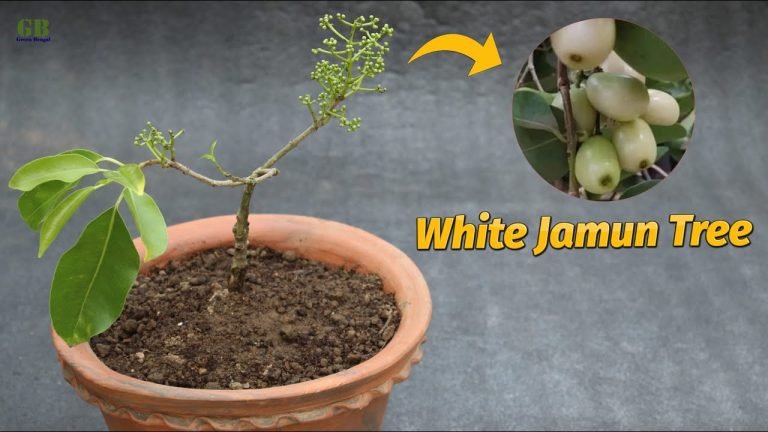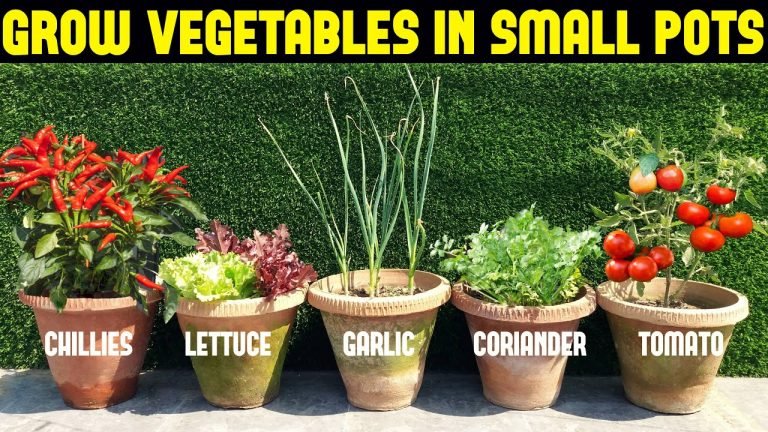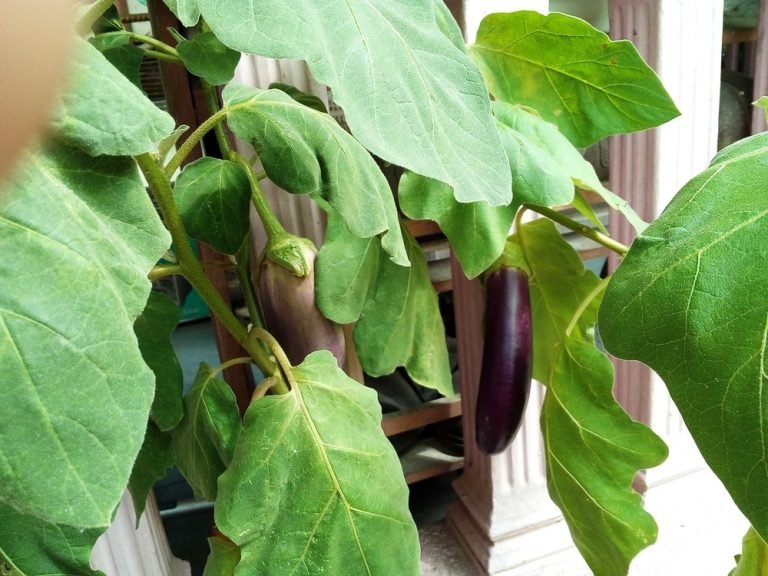how to grow fig tree in a pot – [Beginners Guide]
Have you ever considered growing a fig tree in a pot? Not only is it a fun and rewarding experience, but it also allows you to enjoy fresh figs right from your own backyard or balcony. As someone who has successfully grown figs in pots for years, I can attest to the convenience and satisfaction of this gardening endeavor.
Growing a fig tree in a pot is an excellent idea for several reasons. Firstly, it allows those with limited space, such as apartment dwellers or urban gardeners, to still experience the joys of gardening and growing their own produce. Secondly, it gives you more control over the environment and growing conditions of the tree, ensuring it receives the necessary care and attention to thrive. Additionally, it makes it easier to move the tree around, whether to a sunnier spot or indoors during harsh weather.
In this guide, we’ll walk through the steps of successfully growing a fig tree in a pot, from choosing the right variety to planting and maintaining it. We’ll also discuss some common problems you may encounter and how to troubleshoot them. With a bit of patience, care, and attention, you’ll be able to harvest your own sweet and delicious figs in no time.
So, if you’re ready to embark on this exciting gardening adventure, let’s dive in and explore how to grow a fig tree in a pot!
Pot or container selection
When it comes to growing a fig tree in a pot, selecting the right type and size of the pot is essential for its growth and health. Here are some factors to consider when choosing a pot for your fig tree:
Size and capacity
Fig trees are known for their extensive root systems, which means they require a large pot to grow in. As a general rule, choose a pot that is at least 16 inches (40 cm) in diameter and 18 inches (45 cm) deep to allow the roots enough room to spread and grow.
If you’re planting a young fig tree, you can opt for a smaller pot and transplant it as it grows. However, keep in mind that fig trees do not like to be disturbed, so it’s best to choose a larger pot from the start to avoid having to repot it frequently.
Construction
The construction of the pot is also crucial for the fig tree’s growth and health. Here are some things to consider:
- Material: Choose a pot that is made of a durable material, such as ceramic, plastic, or fiberglass. Avoid using pots made of metal, as they can get too hot in the sun and damage the roots. Similarly, avoid pots made of untreated wood, which can rot and break down over time.
- Drainage: Make sure the pot has drainage holes in the bottom to allow excess water to drain out. Fig trees do not like to sit in water, so it’s crucial to have good drainage to avoid root rot.
- Style: You can choose a decorative pot or a more utilitarian style, depending on your preference. Just make sure the pot is functional and has enough space for your fig tree to grow.
Overall, selecting the right size and construction of the pot is essential for the growth and health of your fig tree. By choosing a large and durable pot with good drainage, you can help your fig tree thrive and produce delicious fruit.
Make suitable soil mix
Growing fig trees in pots requires a well-draining and nutrient-rich soil mix. The ideal soil mix for fig trees should be well-aerated and moisture-retentive. A good mix should consist of peat moss, perlite or vermiculite, and a good quality potting soil. Perlite or vermiculite helps to improve the soil’s drainage, while peat moss helps to retain moisture, and the potting soil provides the necessary nutrients that the fig tree needs to grow.
It’s also important to ensure that the soil mix has the right pH level, as fig trees prefer a slightly acidic soil pH level between 6.0 and 6.8. You can use a pH test kit to check your soil’s pH level and adjust it accordingly using lime or sulfur.
Adding organic matter to the soil mix is also beneficial for fig trees, as it improves the soil’s structure and nutrient content. Adding compost, aged manure, or bone meal to the soil mix will help to provide the fig tree with the necessary nutrients for optimal growth.
In summary, the ideal soil mix for growing fig trees in pots should be well-draining, nutrient-rich, and have a slightly acidic pH level. By using a high-quality potting mix, adding amendments such as compost and organic fertilizers, and checking and adjusting the pH level, you can give your fig tree the best chance of success.
How to plant the fig tree?
Planting a fig tree in a pot at home can be a rewarding experience, and here’s a step-by-step guide to help you get started:
Step 1: Choose the right pot
Select a pot that is at least 18 inches in diameter and 16 inches deep to provide enough space for the root system of your fig tree to grow. The pot should have drainage holes to allow excess water to drain away from the roots.
Step 2: Choose the right soil mix
Use a well-draining, nutrient-rich potting mix that is formulated for fruit trees. You can make your own mix by combining equal parts of peat moss, perlite, and compost.
Step 3: Add soil mix to the pot
Fill the pot with enough soil mix so that the top of the root ball of the fig tree is level with the soil surface.
Step 4: Plant the fig tree
Carefully remove the fig tree from its original container and loosen any tightly bound roots. Place the fig tree in the center of the pot, and fill in around the root ball with the soil mix. Gently press the soil to remove any air pockets.
Step 5: Water the fig tree
Water the fig tree well after planting to ensure that the soil is moist around the root ball. Be careful not to overwater, as this can cause root rot.
Step 6: Provide support for the fig tree (optional)
Depending on the size and variety of your fig tree, it may need support as it grows. If necessary, insert a stake into the pot and tie the tree to it loosely with a soft, flexible tie.
Step 7: Place the pot in a suitable location
Choose a location that receives full sunlight for at least 6-8 hours a day. Keep the pot away from any drafts or extreme temperatures.
Step 8: Water and fertilize the fig tree
Water the fig tree deeply once or twice a week, depending on the weather and the size of the pot. Fertilize the tree with a balanced, slow-release fertilizer in the spring and midsummer. Follow the instructions on the fertilizer package for the recommended amount and frequency.
By following these steps, you can successfully plant and grow a fig tree in a pot at home.
How to care for fig tree?
Growing fig trees in a pot is a great way to enjoy fresh figs even if you don’t have space for a full-sized tree. Here are some tips for caring for your fig tree in a pot:
Watering Requirement
Figs require consistent moisture to produce sweet, juicy fruit. Water the tree deeply once or twice a week, depending on the weather and soil conditions. Stick your finger about an inch into the soil to check the moisture level. If it feels dry at that depth, it’s time to water. Avoid letting the soil become waterlogged, as this can cause root rot.
Fertilizer Requirement
Figs are moderate feeders and benefit from a balanced fertilizer, such as a 10-10-10 formula. Fertilize your fig tree once a month during the growing season (spring and summer) with a liquid or granular fertilizer. Use half the recommended amount for potted plants, as they don’t require as much fertilizer as plants in the ground.
Sunlight Needs
Figs need plenty of sunlight to thrive, so choose a spot in your garden or patio that gets at least 6 hours of direct sunlight per day. If you don’t have a sunny spot outdoors, you can also grow figs in a sunny window indoors using a grow light.
Pruning & Training
Pruning and training fig trees can help improve air circulation, increase sun exposure, and make harvesting easier. Prune your fig tree in late winter or early spring before new growth begins. Remove any dead or diseased wood, as well as any branches that are crossing or rubbing against each other. Figs can be trained into a bush shape or a single-stemmed tree shape, depending on your preference. If you choose to train your fig tree into a tree shape, use a stake or bamboo pole to support the trunk and tie the branches to the stake as they grow.
Other Care
In addition to watering, fertilizing, and pruning, here are some other tips for caring for your fig tree in a pot:
- Use a well-draining potting mix to ensure good drainage and prevent waterlogging.
- Apply a layer of organic mulch around the base of the tree to help retain moisture and suppress weeds.
- Protect your fig tree from extreme temperatures by moving it indoors during cold snaps or hot spells.
- Watch out for common pests and diseases, such as spider mites, scale insects, and fungal diseases. Treat any issues promptly to prevent them from spreading.
- Harvest figs when they are fully ripe and slightly soft to the touch. You can tell if a fig is ripe by gently squeezing it – if it feels soft and gives a little, it’s ready to eat.
With proper care, your fig tree will provide you with delicious fruit for years to come.
Common problems
Other Issues
In addition to the problems mentioned above, cherry tomatoes grown in pots may also face other issues such as:
- Root bound: When the roots of the cherry tomato plant outgrow the pot, it can become root bound, which can lead to stunted growth and poor production. To prevent this, it’s important to transplant the plant to a larger pot when necessary.
- Waterlogging: Overwatering can lead to waterlogging, which can suffocate the roots and lead to root rot. To prevent this, make sure the pot has drainage holes and avoid overwatering the plant.
- Heat stress: Cherry tomatoes are sensitive to heat stress, which can cause the flowers to drop off and reduce fruit production. To prevent heat stress, provide shade during the hottest parts of the day and make sure the plant is well-watered.
- Nutrient deficiency: If the cherry tomato plant is not getting enough nutrients, it may develop nutrient deficiencies, which can lead to poor growth and production. To prevent this, fertilize the plant regularly with a balanced fertilizer according to the package instructions.
Harvesting & storing homegrown fig tree
When it comes to harvesting and storing figs, timing is also crucial to ensure that they are at their best flavor and texture. Figs should be harvested when they are fully ripe, as they do not continue to ripen once they are picked. Here are some tips on how to know when your figs are ready for harvesting and how to store them:
When to Harvest Figs
Figs are ready for harvest when they are fully ripened, and their skins are soft to the touch. They should also have a slightly wrinkled appearance and be slightly droopy. The fruit should be harvested gently, so as not to damage the delicate skin or fruit. If you need to tug or pull hard to get the fruit to detach from the stem, it is not yet ripe and should be left on the tree. Ripe figs will typically be ready to harvest in late summer or early fall, depending on the climate and growing conditions.
Storing Figs
Figs should be eaten or used within a few days of harvesting, as they are highly perishable and do not keep well. Here are some tips for storing figs:
- Store freshly picked figs in a single layer in a shallow container or basket at room temperature for no more than two to three days. They can also be stored in the refrigerator for a few days, but should be used as soon as possible.
- Do not wash figs until you are ready to eat them, as this can cause them to spoil more quickly.
- If you need to store figs for a longer period, they can be frozen. To freeze figs, wash and dry them, then slice or chop them and spread them out on a baking sheet. Once frozen, transfer them to a resealable freezer bag and store them in the freezer for up to six months. They can be used in smoothies, jams, or other recipes.
In summary, harvesting figs at the right time and storing them properly can help ensure that you enjoy the best flavor and texture from your homegrown figs.
Growing fig tree in container – Conclusion
Congratulations, you now have a good understanding of how to grow a fig tree in a pot! By following the steps outlined in this guide, you can successfully plant and care for your fig tree, and enjoy the benefits of having fresh, homegrown figs. Growing a fig tree in a pot is a great option for those with limited space, and it’s a fun and rewarding way to try your hand at gardening. Remember to choose the right pot and soil mix, provide your tree with the right amount of sunlight and water, and watch out for common problems such as pests and diseases. By implementing these tips and techniques, you’ll be well on your way to growing a healthy, fruitful fig tree in your own home. So why not give it a try and enjoy the taste of your very own homegrown figs!







